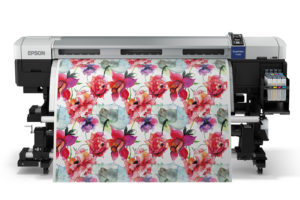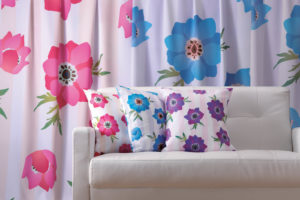
Advances in technology are making custom graphics easier, more affordable and much more impressive.
Fabric printing has come a long way from the days when vinyl banners were the norm in signage and screen-printed T-shirts were the gold standard in custom apparel. “Advancements in digital printing technology have made it easy to print photorealistic images onto fabrics,” says Lily Hunter, product manager, textiles and consumables, for Roland DGA, Irvine, Calif. “Customizing various types of fabrics with colorful, eye-catching graphics has become extremely popular.”
This has led manufacturers of fabrics and printers to improve technologies that support end products ranging from backlit retail signage to one-of-a-kind yoga pants. But even a decade ago, the options for digital fabric printing were very limited.
“Textile printers were either high-volume textile machines for the few large-scale textile production companies or low-volume printers that were largely based on printers designed for photographic paper printing,” says Tim Check, product manager, professional imaging, for Epson America Inc., Long Beach, Calif. “Each component of the printing process involved a different company and required the user to have the knowledge and expertise to make the system functional.”

Limitations existed on the fabric side as well. “When we first started making fabric for the industry in 2007, it was basically a banner fabric,” says Ken Bach, business development manager for Aberdeen Fabrics, Aberdeen, N.C. “It was kind of rigid and not very dynamic, but you could print on it and it worked.”
With advancements in printer technology, however, “we could produce stretchy fabrics that had more functionality to them,” Bach adds.
According to Laura Wilson, west coast print media specialist for Dazian Creative Fabric Environments, So. Hackensack, N.J., customers now want a higher-end look and feel on their printed fabrics. “We definitely see growth in some of our higher-end knits and woven products,” she says.
Improvements in printer output speed and quality have enabled end-users to achieve a variety of customized, sophisticated looks on a many different kinds of fabrics and products. Digital printing advancements also have made short-run production easier and more cost-effective, Hunter says.
Hunter adds that a merging of different industries allows “traditional sign shops to cross over into apparel decoration, tradeshow exhibit graphics or even interior décor.”
The evolving landscape of digital fabric printing has broadened opportunities for fabric suppliers, finishers, specialty fabrics manufacturers and printers as customer requests continue to spark new product development.
Holly O’Dell is a freelance writer based in Joshua Tree, Calif.
 TEXTILES.ORG
TEXTILES.ORG


